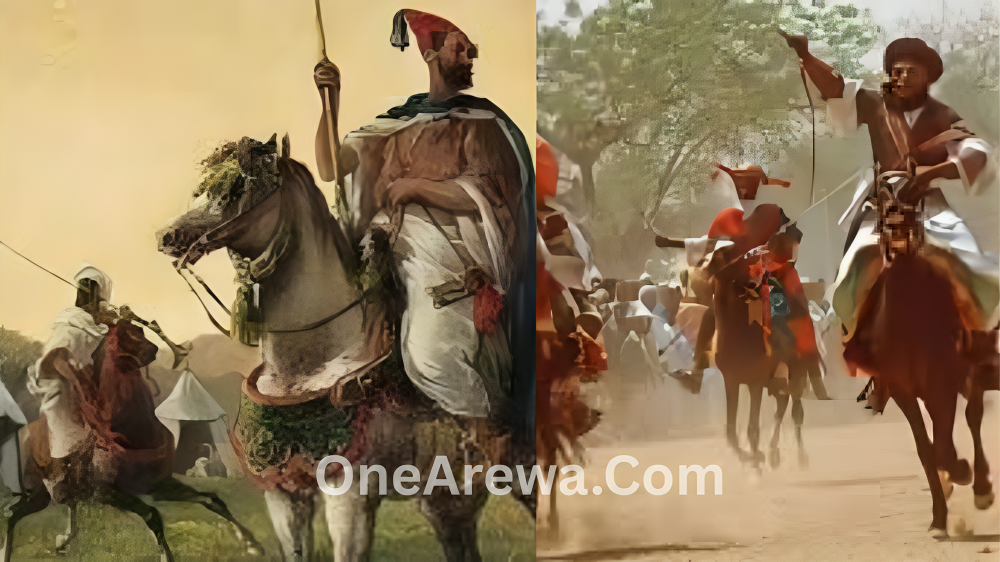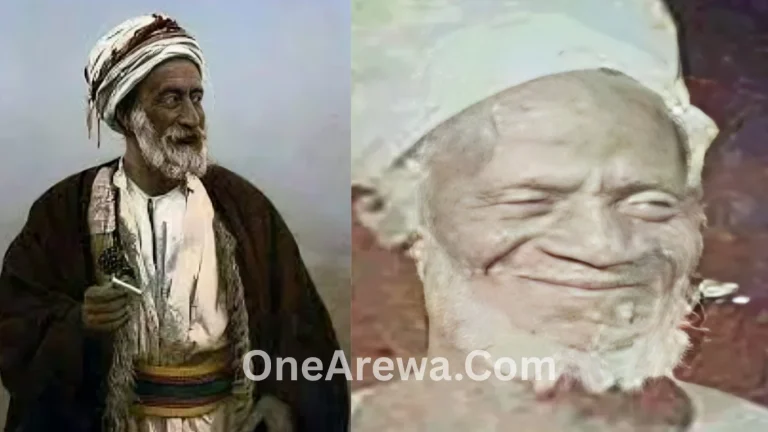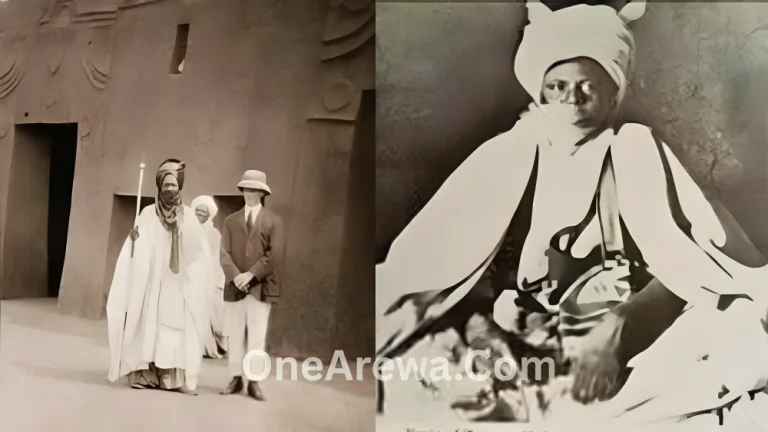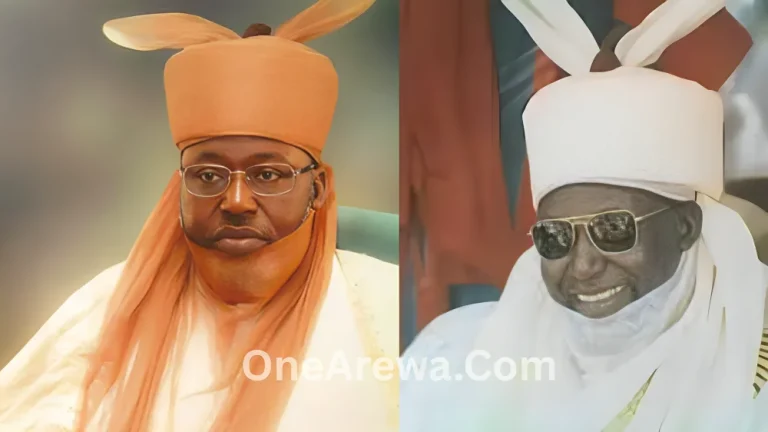Muhammad Yunfa: The King Who Tried to Stop Usman ɗan Fodio – And Lost a Kingdom
Muhammad Yunfa: The King Who Tried to Stop Usman ɗan Fodio – And Lost a Kingdom
Muhammad Yunfa ibn Nafata, widely known as Sarkin Gobir, was the ruler of the Gobir Kingdom in Hausaland from around 1801 to 1808.
Born into the royal family of Gobir and the son of Sarki Nafata, Yunfa rose to power during a time of growing religious reform movements led by Shehu Usman ɗan Fodio, whom he had once studied under.
Initially tolerant, Yunfa later viewed Usman ɗan Fodio’s increasing influence as a threat to his authority and attempted to assassinate him in 1804, an act that sparked the Fulani Jihad.
Usman fled to Gudu and declared a Hijra, gaining massive support from Fulani herders and oppressed Hausa commoners.
Yunfa led several military campaigns to suppress the uprising but faced defeats in battles, including the Battle of Tsuntua and finally the Battle of Alkalawa in 1808, where he was killed, and his capital Alkalawa, fell.
His death marked the collapse of the Gobir dynasty’s power and the rise of the Sokoto Caliphate, which became one of the most significant Islamic empires in 19th-century Africa.
Muhammad Yunfa is remembered as a controversial figure, a defender of traditional Hausa kingship to some, and an oppressor resisting reform to others, but his reign was undeniably a turning point in West African Islamic and political history.
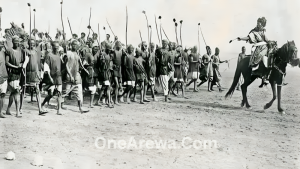
Muhammad Yunfa Wiki Profile
-
Full Name: Sarki Muhammad Yunfa
-
Title: King of Gobir (Sarkin Gobir)
-
Reign: Circa 1801 – 1808
-
Region: Gobir Kingdom (present-day Northern Nigeria)
-
Known For: Opposing Shehu Usman ɗan Fodio and the Fulani Jihad
-
Former Student of: Usman ɗan Fodio (before becoming adversaries)
-
Major Conflict: The Fulani Jihad (1804–1808)
-
Notable Event: Attempted to assassinate Usman ɗan Fodio in 1804
-
Death: Killed in 1808 during the Battle of Alkalawa
-
Legacy: His defeat led to the fall of Gobir and the rise of the Sokoto Caliphate
-
Historical Significance: Symbolizes the collapse of the Hausa aristocracy and the spread of Islamic reform in West Africa.
Check Out: The Legacy of Muhammad Rumfa: Personal Life, Power, and Reform in Ancient Kano
Early Life and Background of Muhammad Yunfa
Muhammad Yunfa was born into the royal family of the Gobir Kingdom, one of the seven original Hausa city-states in what is now northwest Nigeria.
He was the son of Sarki Nafata, a former ruler of Gobir known for his resistance to Islamic reformist movements. Growing up in a period marked by increasing Islamic awareness and political instability, Yunfa was exposed to both traditional Hausa leadership customs and the rising influence of Islamic scholarship.
As a young prince, Yunfa studied under Shehu Usman ɗan Fodio, one of the most respected Islamic scholars of the time. Their early relationship was cordial, with Usman serving as a religious mentor.
However, as Yunfa matured and began preparing for leadership, tensions began to grow.
He became wary of Usman’s growing influence, particularly his appeal among the Fulani herders, rural peasants, and even members of the elite who were dissatisfied with the corruption and syncretic religious practices of the ruling class.
By the time he ascended the throne around 1801, Yunfa had already begun distancing himself from the reformist ideals of his former teacher.
Instead, he adopted a defensive and authoritarian leadership style, aimed at preserving the traditional Hausa political and religious order, even at the cost of suppressing Islamic reformers.
This laid the foundation for the eventual conflict that would define his reign and alter the course of West African history.
Rise to Power of Muhammad Yunfa
Muhammad Yunfa rose to power around 1801 following the death or abdication of his predecessor, likely after a succession contest typical of Hausa monarchies.
As the Sarkin Gobir (King of Gobir), Yunfa inherited a kingdom that was both politically influential and religiously divided.
The Gobir Kingdom had long been a center of military strength and political dominance among the Hausa city-states, but by the time of Yunfa’s ascension, it was under growing pressure from within, particularly from Islamic reformers who criticized the ruling class for blending Islam with traditional pagan practices.
Yunfa’s claim to the throne was significant, not just because he was the son of Sarki Nafata, but also because of his prior relationship with Usman ɗan Fodio, the emerging spiritual and political leader of Islamic revivalism in the region.
Ironically, despite having studied under Usman ɗan Fodio, Yunfa chose a path that directly opposed the reformist ideology his former teacher advocated.
Upon becoming king, Yunfa sought to assert his authority by reinforcing taxation systems, maintaining the status quo, and limiting the influence of Islamic scholars, especially those gaining popularity among the Fulani and the rural poor.
His rise to power was seen by many as a turning point, both for the Gobir kingdom and for the region at large.
While Yunfa aimed to preserve the traditional Hausa leadership, his increasingly repressive stance against reformers would ultimately backfire, leading to widespread unrest, open rebellion, and the beginning of a religious revolution that would transform the political map of West Africa.
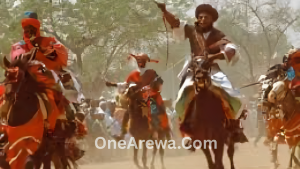
Conflict with Usman ɗan Fodio
The conflict between Muhammad Yunfa and Shehu Usman ɗan Fodio stands as one of the most defining episodes in West African history.
Though Yunfa had once been a student of Usman ɗan Fodio, their relationship deteriorated drastically after Yunfa ascended the throne of Gobir around 1801.
As Usman ɗan Fodio’s influence continued to grow among the Fulani, rural Hausa peasants, and discontented elites, Yunfa began to see him not as a spiritual guide, but as a political threat.
Usman ɗan Fodio was openly critical of the moral corruption, heavy taxation, and un-Islamic practices of the Hausa rulers, including Yunfa.
His teachings called for religious purification and social justice, which resonated with many people who felt exploited by the existing system.
This growing movement alarmed Yunfa and his court, who feared the erosion of their traditional authority.
In 1804, Yunfa attempted to eliminate the threat by assassinating Usman ɗan Fodio, but the attempt failed. Instead of silencing the reformer, the failed attack only strengthened Usman’s cause.
Usman and his followers fled to Gudu, where he declared a Hijra (migration), symbolizing religious persecution and echoing the Prophet Muhammad’s migration from Mecca to Medina. Shortly afterward, Usman declared a jihad (holy war) against the oppressive rulers of Hausaland.
The conflict escalated into a full-scale war known as the Fulani Jihad, with Yunfa rallying his allies across Hausa kingdoms to fight the growing revolutionary movement.
Despite having larger armies and fortified cities, Yunfa’s forces suffered defeats at the hands of the highly motivated and religiously driven Jihadists.
The most decisive blow came at the Battle of Alkalawa in 1808, where Yunfa was killed and the capital of Gobir was captured, effectively ending his reign and paving the way for the establishment of the Sokoto Caliphate under Usman ɗan Fodio.
This conflict marked the collapse of the Gobir monarchy and the beginning of a new political and religious order in West Africa.
Check Out: Hauwa Ibrahim: Nigeria’s Fearless Human Rights Lawyer and Activist
The Fulani Jihad and the Fall of Gobir
The Fulani Jihad, initiated in 1804 by Shehu Usman ɗan Fodio, was a revolutionary religious and political movement that ultimately led to the fall of the Gobir Kingdom and the death of Sarki Muhammad Yunfa.
Sparked by years of growing tension between the Islamic reformers and the ruling Hausa elites, the jihad began after Yunfa’s failed attempt to assassinate Usman ɗan Fodio, a miscalculation that transformed a peaceful call for reform into a full-scale Islamic uprising.
Usman ɗan Fodio, having declared a Hijra to Gudu, rallied a large coalition of Fulani nomads, rural Hausa peasants, and even sympathetic scholars and warriors, who were united by the desire for religious purification, justice, and an end to oppression and exploitation.
He declared jihad not only on Gobir but also on other Hausa states that opposed his vision of a purified Islamic society governed by Sharia law.
In response, Muhammad Yunfa, backed by the ruling elite of Gobir and allied Hausa kingdoms, organized a series of military campaigns to crush the uprising.
However, his forces, though better equipped, were outmaneuvered by the highly motivated jihadist fighters.
Major battles such as the Battle of Tsuntua and others saw devastating losses for Yunfa’s army.
The turning point came in 1808 at the Battle of Alkalawa, the capital of Gobir.
In this climactic battle, Yunfa was killed, and the city was sacked, marking the collapse of Gobir’s power.
The fall of Gobir symbolized the end of the Hausa aristocratic dominance and the rise of a new Islamic order.
In place of the old kingdoms, Usman ɗan Fodio established the Sokoto Caliphate, which became the largest and most powerful Islamic state in 19th-century West Africa.
Yunfa’s resistance, though fierce, could not withstand the religious fervor and mass support behind the jihad.
His defeat marked the close of an era and the beginning of a new one shaped by Islamic governance and scholarship.
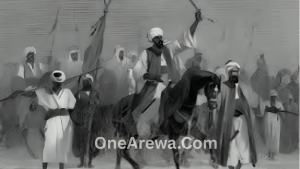
The Fulani Jihad and the Fall of Gobir
The Fulani Jihad, launched in 1804 by Shehu Usman ɗan Fodio, was a transformative Islamic revolution that led to the collapse of the Gobir Kingdom and the death of Sarki Muhammad Yunfa in 1808.
Tensions had been building for years between the Hausa ruling class, accused of religious corruption, oppression, and injustice, and a growing Islamic reform movement led by ɗan Fodio.
When Muhammad Yunfa attempted to assassinate ɗan Fodio, the act backfired, igniting a full-blown uprising.
Following the failed assassination, Usman ɗan Fodio fled to Gudu, declared a Hijrah (migration), and soon proclaimed a jihad (holy war) against Yunfa and other Hausa rulers.
His call resonated with Fulani pastoralists, rural Hausa Muslims, and disillusioned elites who rallied behind the cause of purifying Islam and replacing unjust rulers with Islamic governance based on Sharia.
Despite Yunfa’s access to organized armies and fortified cities, his forces were repeatedly defeated by the motivated jihadists.
Battles like Tsuntua (1804) and others weakened Gobir’s power. In 1808, the jihadists launched a final attack on Alkalawa, the capital of Gobir.
The city was captured, Muhammad Yunfa was killed, and the Gobir monarchy was overthrown.
This marked the end of Gobir’s dominance and the birth of the Sokoto Caliphate, an Islamic empire that would go on to control most of Northern Nigeria and parts of West Africa.
The fall of Gobir was not just a military defeat but a civilizational shift, replacing traditional Hausa monarchies with a centralized Islamic state that endured for over a century.
Check Out: Maryam Babangida: The Iconic First Lady Who Transformed Women’s Roles in Nigeria
Legacy of Muhammad Yunfa
The legacy of Muhammad Yunfa is deeply intertwined with the rise of Islamic reform in West Africa and the fall of the old Hausa aristocracy.
Though often remembered as the ruler who opposed Shehu Usman ɗan Fodio and lost the Kingdom of Gobir, his reign played a critical role in shaping the course of West African history.
Yunfa’s resistance to Islamic reform was rooted in a desire to preserve the traditional authority of the Hausa ruling class and maintain political control over a rapidly changing society.
However, his decision to violently suppress the movement of ɗan Fodio, including his failed assassination attempt in 1804, unintentionally strengthened the very revolution he sought to crush.
His actions acted as a catalyst for the Fulani Jihad, a movement that would go on to dismantle not only Gobir but also other Hausa kingdoms, replacing them with the Sokoto Caliphate.
While many view Yunfa as a symbol of resistance to change, others see him as a tragic figure, a ruler caught between tradition and reform, whose downfall was as much the result of circumstance as of choice.
His death at Alkalawa in 1808 marked not just the collapse of his reign but the end of a political era and the beginning of a religious and cultural transformation that reshaped the identity of Northern Nigeria.
Today, Muhammad Yunfa’s legacy serves as a reminder of the complex tensions between politics, religion, and reform in African history.
His story is studied not only for its historical impact but also for the lessons it offers about leadership, resistance, and the inevitability of change.
FAQs
1: Who was Muhammad Yunfa?
Muhammad Yunfa was the King of Gobir (Sarkin Gobir) in the early 19th century, best known for his opposition to Shehu Usman ɗan Fodio and his role in the Fulani Jihad.
2: What is Muhammad Yunfa most remembered for in history?
He is most remembered for attempting to suppress the Islamic reform movement led by Usman ɗan Fodio and for being defeated during the Fulani Jihad, which led to the fall of the Gobir Kingdom.
3: Was Muhammad Yunfa ever a student of Usman ɗan Fodio?
Yes, before their political and religious conflict, Muhammad Yunfa was once a student of Shehu Usman ɗan Fodio.
4: What event triggered the Fulani Jihad?
Yunfa’s attempted assassination of Usman ɗan Fodio in 1804, combined with growing religious tensions, was the spark that ignited the Fulani Jihad.
5: What happened during the Battle of Alkalawa?
In 1808, the jihadists attacked and captured Alkalawa, the capital of Gobir. Muhammad Yunfa was killed during this battle, marking the end of his reign.
6: What was the outcome of Yunfa’s resistance?
His defeat resulted in the destruction of the Gobir Kingdom and the establishment of the Sokoto Caliphate, a powerful Islamic empire in West Africa.
7: How is Muhammad Yunfa viewed in history today?
He is viewed as a symbol of traditional Hausa resistance to Islamic reform. Some see him as a defender of sovereignty, while others view him as a tragic figure who resisted necessary change.
8: What was the Sokoto Caliphate that emerged after Yunfa’s fall?
It was an Islamic empire founded by Usman ɗan Fodio after the jihad, becoming one of the most influential political and religious entities in 19th-century Africa.
9: What role did the Fulani ethnic group play in the Jihad against Yunfa?
The Fulani, especially the pastoralists, were key supporters of Usman ɗan Fodio, supplying fighters and ideological backing for the jihad movement.
10: What year did Muhammad Yunfa die?
He died in 1808 during the Battle of Alkalawa.
Check Out: Alhaji Mohammed Awwal Ibrahim: From Governor to Emir of Suleja – A Full Biography
